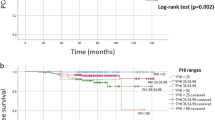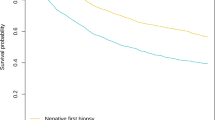Abstract
Background
Prostate atrophy (PA) is commonly identified in prostate biopsies. Previous studies suggest PA may be associated with lower PCa risk. However, it remains unclear whether PA is associated with smaller, less aggressive, and less advanced tumors. Thus, we sought to determine whether the presence and severity of baseline PA in men with initial biopsy negative for prostate cancer (PCa) is associated with PCa volume at 2- and 4-year repeat biopsy.
Methods
We performed a retrospective analysis of 927 men 50–75-years-old with negative baseline biopsy and positive 2- or 4-year repeat biopsy for PCa in the Reduction by Dutasteride of PCa Events study. PA (present or absent), PA severity (mild or moderate/marked), and tumor volume were determined by central pathology. The association of baseline PA with repeat biopsy PCa volume was evaluated with linear and Poisson regressions in uni- and multivariable analyses.
Results
PA was identified in 559 (60%) baseline biopsies and was mild in 491 (88%) and moderate/marked in 68 (12%). PA was associated with larger prostate volumes (P < 0.001). At 2-year biopsy, PA was associated with lower overall mean total tumor volume (2.21 vs. 2.94 µL; P = 0.016), mean number of biopsy cores involved (1.85 vs. 2.08; P = 0.016), mean percent of cores involved (18.4% vs. 20.7%; P = 0.008), average core involvement (0.23 vs. 0.29 µL; P = 0.019) and overall mean percent tumor involvement (1.82% vs. 2.33%; P = 0.018). Similar results were found in multivariable analysis and analysis of 4-year repeat biopsies. Compared to mild PA, moderate/marked PA was associated with greater reduction in tumor volume.
Conclusion
Amongst subjects with repeat prostate biopsy positive for PCa after negative baseline biopsy, the presence and severity of baseline PA were associated with lower PCa volume. This suggests PA may be associated with less aggressive PCa.
This is a preview of subscription content, access via your institution
Access options
Subscribe to this journal
Receive 4 print issues and online access
$259.00 per year
only $64.75 per issue
Buy this article
- Purchase on Springer Link
- Instant access to full article PDF
Prices may be subject to local taxes which are calculated during checkout
Similar content being viewed by others
References
Billis A, Freitas LL, Magna LA, Ferreira U. Inflammatory atrophy on prostate needle biopsies: is there topographic relationship to cancer? Int Braz J Urol. 2007;33:355–60; discussion 361–353.
Davidsson S, Fiorentino M, Andren O, Fang F, Mucci LA, Varenhorst E, et al. Inflammation, focal atrophic lesions, and prostatic intraepithelial neoplasia with respect to risk of lethal prostate cancer. Cancer Epidemiol Biomarkers Prev. 2011;20:2280–7.
Asimakopoulos AD, Miano R, Mauriello A, Costantini S, Pasqualetti P, Liberati E, et al. Significance of focal proliferative atrophy lesions in prostate biopsy cores that test negative for prostate carcinoma. Urol Oncol. 2011;29:690–7.
Postma R, Schroder FH, van der Kwast TH. Atrophy in prostate needle biopsy cores and its relationship to prostate cancer incidence in screened men. Urology. 2005;65:745–9.
Billis A. Prostatic atrophy: an autopsy study of a histologic mimic of adenocarcinoma. Mod Pathol. 1998;11:47–54.
Servian P, Celma A, Planas J, Placer J, de Torres IM, Olivan M, et al. Clinical significance of proliferative inflammatory atrophy finding in prostatic biopsies. Prostate. 2015;75:1669–75.
Moreira DM, Bostwick DG, Andriole GL, Peterson BL, Cohen HJ, Castro-Santamaria R, et al. Baseline prostate atrophy is associated with reduced risk of prostate cancer in men undergoing repeat prostate biopsy. J Urol. 2015;194:1241–6.
Billis A. Prostatic atrophy. Clinicopathological significance. Int Braz J Urol. 2010;36:401–9.
De Marzo AM, Marchi VL, Epstein JI, Nelson WG. Proliferative inflammatory atrophy of the prostate: implications for prostatic carcinogenesis. Am J Pathol. 1999;155:1985–92.
De Marzo AM, Meeker AK, Zha S, Luo J, Nakayama M, Platz EA, et al. Human prostate cancer precursors and pathobiology. Urology. 2003;62:55–62.
Andriole GL, Bostwick DG, Brawley OW, Gomella LG, Marberger M, Montorsi F, et al. Effect of dutasteride on the risk of prostate cancer. N Engl J Med. 2010;362:1192–202.
Wu C, Moreira DM, Gerber L, Rittmaster RS, Andriole GL, Freedland SJ. Diabetes and prostate cancer risk in the REDUCE trial. Prostate Cancer Prostatic Dis. 2011;14:326–31.
Humphrey PA. Atrophy of the prostate on needle biopsy and false-positive diagnosis of malignancy. J Urol. 2011;186:2065–6.
Przybycin CG, Kunju LP, Wu AJ, Shah RB. Partial atrophy in prostate needle biopsies: a detailed analysis of its morphology, immunophenotype, and cellular kinetics. Am J Surg Pathol. 2008;32:58–64.
Prando A, Billis A. Focal prostatic atrophy: mimicry of prostatic cancer on TRUS and 3D-MRSI studies. Abdom Imaging. 2009;34:271–5.
Wang W, Bergh A, Damber JE. Morphological transition of proliferative inflammatory atrophy to high-grade intraepithelial neoplasia and cancer in human prostate. Prostate. 2009;69:1378–86.
Muller RL, Gerber L, Moreira DM, Andriole G, Castro-Santamaria R, Freedland SJ. Serum testosterone and dihydrotestosterone and prostate cancer risk in the placebo arm of the reduction by dutasteride of prostate cancer events trial. Eur Urol. 2012;62:757–64.
Moreira DM, Nickel JC, Gerber L, Muller RL, Andriole GL, Castro-Santamaria R, et al. Baseline prostate inflammation is associated with a reduced risk of prostate cancer in men undergoing repeat prostate biopsy: Results from the REDUCE study. Cancer. 2014;120:190-6.
Meirelles LR, Billis A, Magna LA, Vassallo J, Matsura MA. Prostatic atrophy: immunohistochemical study of hypoxia induced factors. Int Urol Nephrol. 2006;38:577–81.
Billis A, Magna LA. Inflammatory atrophy of the prostate. Prevalence and significance. Arch Pathol Lab Med. 2003;127:840–4.
Acknowledgements
Sources of data: GlaxoSmithKline.
Author information
Authors and Affiliations
Corresponding author
Ethics declarations
Conflict of interest
Drs. Freedland and Andriole served as consultants to GSK and received research support from GSK. Dr. Castro-Santamaria is an employee of GSK. Dr. Moreira declare that he has no competing interests.
Electronic supplementary material
Rights and permissions
About this article
Cite this article
Moreira, D.M., Andriole, G.L., Castro-Santamaria, R. et al. Baseline prostate atrophy is associated with lower tumor volume in men with prostate cancer on repeat biopsy. Prostate Cancer Prostatic Dis 21, 106–112 (2018). https://doi.org/10.1038/s41391-017-0012-y
Received:
Revised:
Accepted:
Published:
Issue Date:
DOI: https://doi.org/10.1038/s41391-017-0012-y



